| Action Engineering - 3D Digital Transformation You Trust | Reference | 2022 |
Action Engineering is a world-renowned consulting firm for 3D-data transformations. With decades of experience and influential status on standards committees, Action is helping to define how MBE is done. They provide a full strategic program of consulting (READY, SET, GO, GROW) to take MBE throughout the product lifecycle. Their comprehensive coaching is a unique combination of unbiased technical expertise and industry-specific change management approaches. They also provide the only MBD-based cross-platform GD&T training in the industry and OSCAR, a curated toolkit of 3D-standards compliant data, tutorials, and videos.
| The digital file produced from any CAD software package that creates a 2D drawing, which is the source for either printed-paper or a digital 2D formatted file (e.g., PDF). These files may or may not retain an associative link to their 3D CAD parent. |
| Technical information presented as a 2D drawing or other static document types that require manual human interpretation. |
| The digital file(s) produced from any CAD software package that contains the 3D model of an object. It may or may not include Product and Manufacturing Information (PMI) annotations. |  |
| Technical information presented as a dynamic 3D model that facilitates machine consumption opportunities while also displaying much of the 3D data for the human reviewer. |
| A term often used to describe a 3D PDF. It is a mathematically inaccurate term because a drawing is inherently 2D, and should not be described as 3D. |
| The capability of 3D data to seamlessly interchange between disparate systems. |  |
| A PDF file that contains 3D geometry with associated text in a dynamic viewport. |
| A method of digitally acquiring and storing the shape and size of an object as a 3D data. |
| A process of joining materials to make objects from 3D data, usually layer upon layer, as opposed to subtractive manufacturing methodologies. | 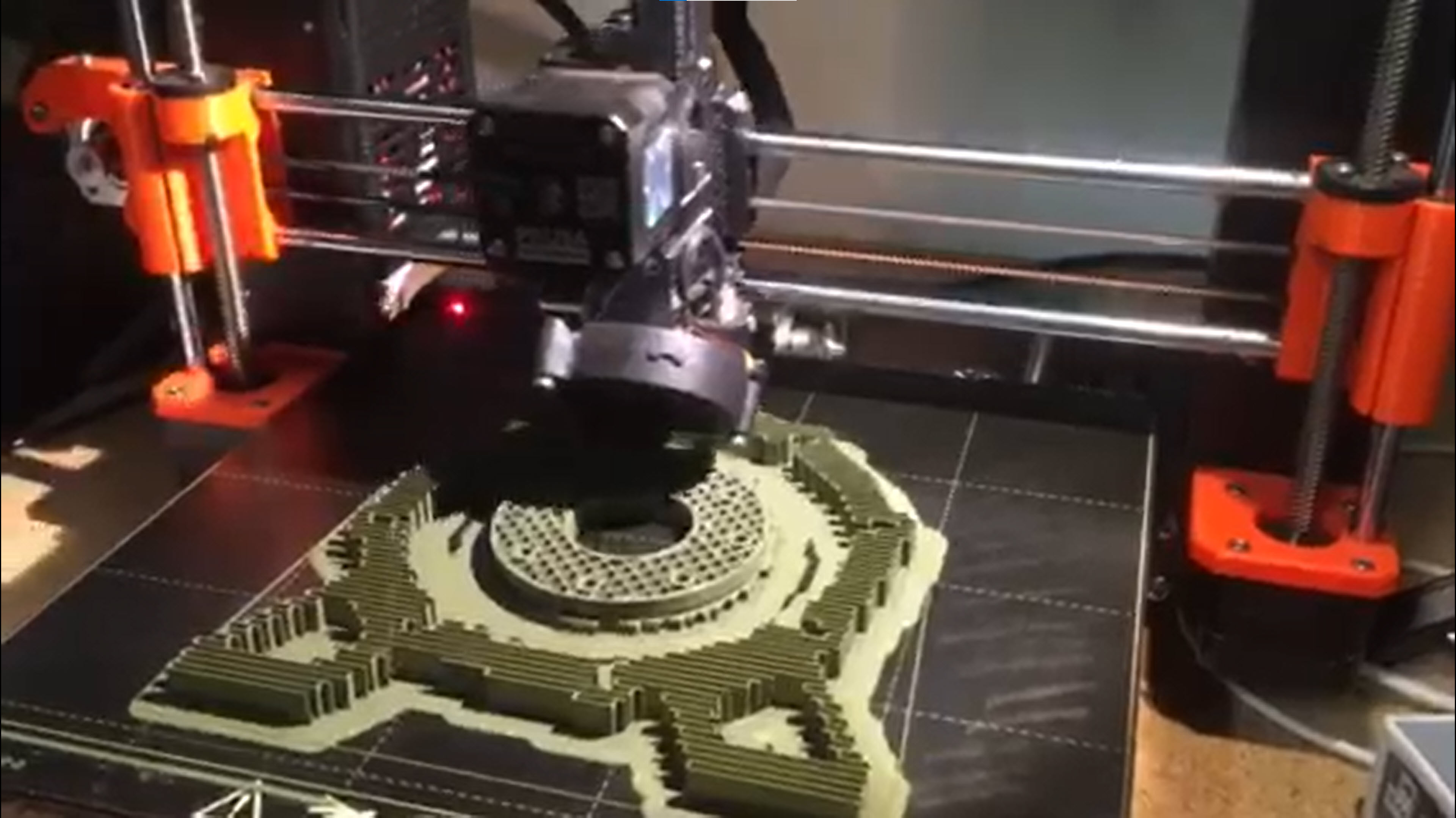 |
| A CAD model that contains additional product definition information required to perform product analysis (static, dynamic, thermal, etc.). Most likely contains mesh elements to make it a Finite Element Model (FEM) and may contain control software to predict the products behavior. This may or may not be a derivative of the parent 3D CAD model. |
| Visible dimensions, tolerances, notes, text, or symbols. | 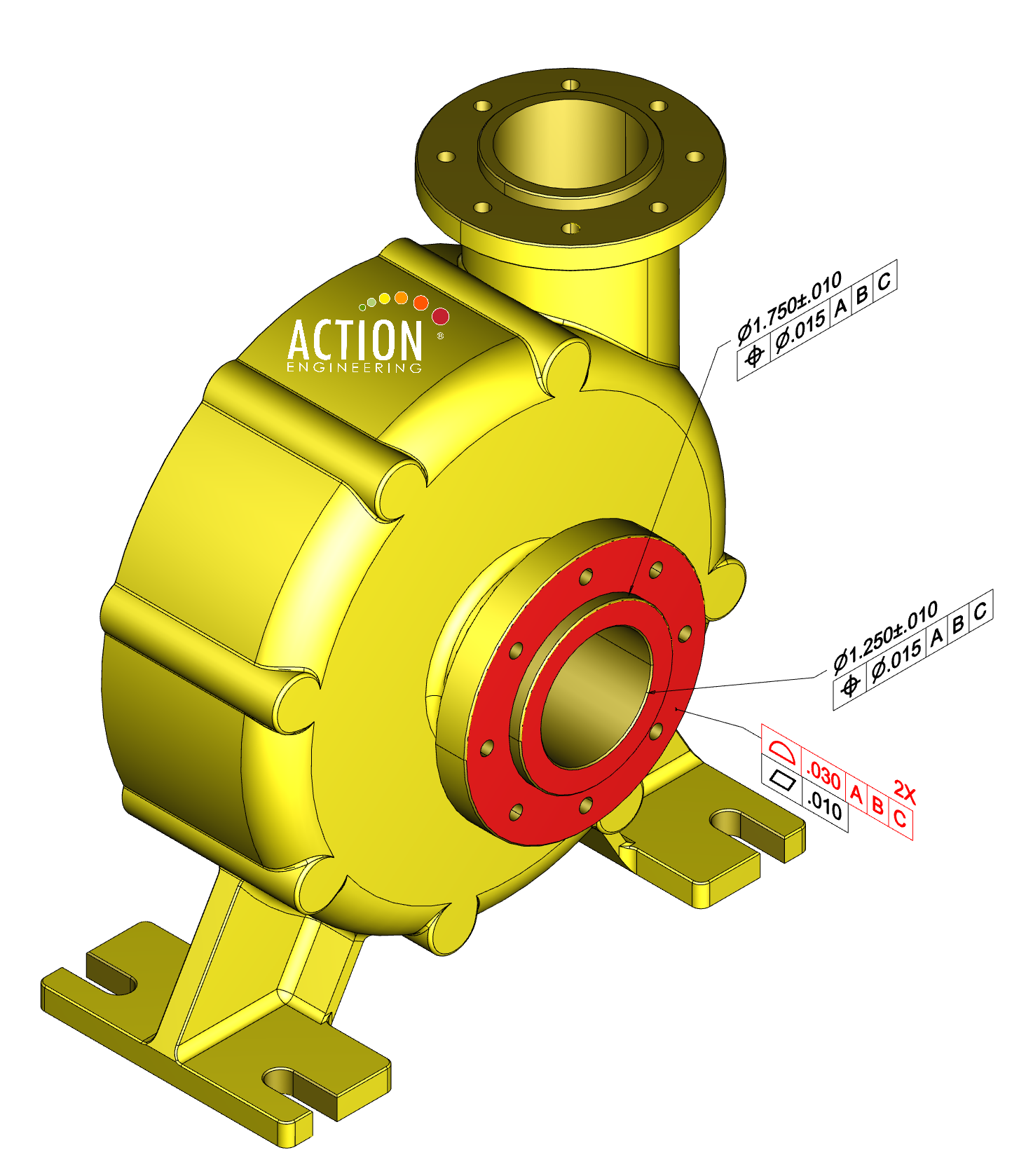 |
| An associative relationship created from a component to assembly references (planes, axis, or coordinate system), or to another component in the assembly to define the component location and orientation within the assembly. |
| A model in which the product described is an assembly of two or more items. |  |
| A dimension, tolerance, note, text, or symbol required to complete the product definition or feature of the product that is not visible but available upon interrogation of the model. | 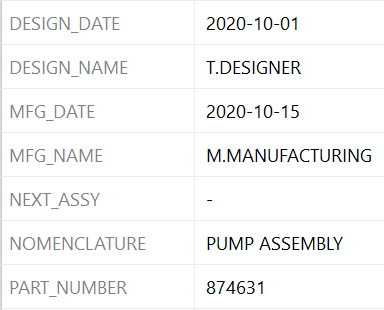 |
| A model view that is primarily used to display annotations, where the surfaces of the model are not perpendicular to the viewing direction. |  |
| CAD Bill of Materials | CAD BOM |
 |
| The CAD bill of materials refers to the 3D CAD history tree of parts and components. It includes only what has been modeled; additional functional needs are captured in the following eBOM stage. |
| The hierarchical relationships among parts in a 3D assembly and among features in a feature-based part. Complex assemblies consist of subassemblies containing parts or possibly more subassemblies. Parts of feature-based CAD models consist of a base feature onto which additional features are applied. Features may themselves have dependent features. |
| Any part or subassembly commonly re-used within an organization’s products. |  |
| A human readable unique identifier. Characteristic IDs are assigned to tolerances within the Authoritative Technical Data to enable human readable tracking from native CAD data to derivative CAD data. The characteristic ID may also be consumed by downstream machine-readable equipment (e.g. inspection report generation). |
| A model that “trees” up into the next higher assembly/installation. |
| A part or subassembly model that is assembled into an assembly or subassembly model. |  |
| Costed Bill of Materials | Costed BOM |
 |
| Bill of materials which includes component costs for each component of the product. These include values for all costing items of a material, sales order or base planning object. |
| Data Package | DP |
 |
| A collection of 3D model geometry, annotations, attributes, and presentation states that includes a lightweight viewable file format that is intended for human readability. It may also contain derivate data and associated lists. |  |
| Silos enable logistical organization, development of expertise, and management of similar mindsets; paper-based practices result in insolated & disconnected 2D data, while model-based practices use connected 3D data with a well-maintained digital thread. |
| The single source authority for the design model, annotations, and attributes. |
| The process of performing metrology operations on an end item using digital data which is connected, traceable, and automated. |
| The engineering bill of materials reflects the design of the product rather than the manufacturing process of the product. eBOMs are typically driven from the CAD model and are usually centric to the final assemblies list of parts or components. |
| A system that manages as-routed data and is the authoritative source for schedule, producer information, and cost. |
| A solid model representation of the outer shape of an assembly that is represented as a single part. |  |
| A model that includes every basic dimension and tolerance value necessary to produce the part by visual inspection of the annotated model alone. Also known as a 3D Drawing. |
| An iterative software-based process that uses human entered constraints and incorporates analysis, machine-learning, and simulations to interpret design requirements for production of multiple 3D geometric models for user evaluation. |
| Pictorial representation of a 3D model or 2D drawing. Generally it is captured as a screen shot. The image can be isometric or planar, cartoon-like, 3D, realistic or line art. |
| A hierarchical diagram of 3D model features that shows their relationships and the order in which they were created. |
| The fourth industrial revolution, occurring now, is manufacturing operations digitally transformed to leverage connected data, machines, and people. A connected factory may use Additive Manufacturing (AM), cybersecurity, Artificial Intelligence (AI), Augmented Reality (AR), autonomous robots, big data analytics, cloud computing, the Internet of Things (IoT), Machine Learning (ML), simulation, and technologies not yet invented to reduce waste in their processes. |
| One item, or two or more items joined together, that is not normally subject to disassembly without destruction or impairment of designed use (e.g., transistor, composition resistor, screw, transformer, and gear). |
| 3D CAD with two or more bodies and/or two or more Mono-Detail Models that represent an inseparable assembly (e.g., weldment). |
| A collection of part and assembly models, combined in an assembly for the sole purpose of describing how a component or subassembly mounts in a very large structure. This assembly does not have a next higher assembly, nor is it typically the top assembly. |
| Each instantiation of a component is called an instance. It may appear that the part model (component) is copied several times within a single assembly, yet the other representations are merely visualizations of the source data. |  |
| An associative link to a part external to the one being worked on. These references are sometimes called external references. For example, a hole may reference its centerline location from another part, creating an associated link from the hole feature to the other part. |
| An automatically generated parts list from the CAD BOM that is optimized for the human user experience and persists digital associativity between the component and the parts list. The purpose is for the human reader to read, view, and navigate the parts list information within the context of the geometry and components. |
| An assembly which has a total of all components (Company, Industry (including fasteners), Supplier), including all the instances (not unique parts) in the assembly are between 200 and 1000 parts. |
| The single source authority for manufacturing. It is a connected derivation of the Design Authority model. Model data is derived from the design authority, but manipulated, translated, verified, and synced as required by the change management process back to the design authority. |
| The manufacturing bill of materials reflects the manufacturing process of the product rather than the design of the product. mBOMs are typically driven by the eBOM and also include all items related to the end product, including packaging or shipping. |
| A system that manages as-built manufacturing information and is the authoritative source for execution records, assembly records, non-conformance records, and dimensional inspection records. It most often captures real-time data. |
| May contain some or all of the Product Model data elements but will vary based on the manufacturing needs of the product. For example, it may be a single 3D solid model in neutral format containing only geometry. The elements contained in the Manufacturing Model are translated and verified from and against the Design Authority model. |
| A set of data defining the process flow and test requirements for new product to be manufactured, which identifies the people, equipment, and facilities required. |
| A system that manages as-planned data and is the authoritative source for the mBOM, inventory, and equipment. |
| A controlled set of instructions that describe in detail how particular tasks, procedures, or processes must be performed; provide a referenced, repeatable framework for communicating the steps needed to complete a task. |
| An assembly which has a total of all components (Company, Industry (including fasteners), Supplier), including all the instances (not unique parts) in the assembly are between 200 and 1000 parts. |
| Data about data. For example, the file name is meta data about a CAD design held as a file. |
| The highest number of significant digits set in the CAD model document. |
| An organization, grouping, naming convention and direction for completeness of models, annotations, attributes and metadata, included in the original model. These basic building blocks facilitate accurate archival and data exchange of TDP Type: 3D. |
| A process that uses models throughout the product lifecycle. |
| An organization that uses digital methodologies as the foundation to enable deployment of products from concept to disposal. |
| An ecosystem defined by software, hardware, infrastructure, and people that supports both a Model-Based Engineering approach, and a Model Based Enterprise. |
| 3D CAD that represents a single piece part. |
| The theoretically perfect representation of a design's geometry as defined by the features' nominal sizes and basic dimensions. |
| Originating 3D Model, generally in native CAD software format, that is the working model for changes to geometry, annotations and attributes. From the original model flows the product model which is controlled as the record of authority. All data elements within the model maintain associativity to one another. |
| A model into which child models “tree” up. Also referred to as the next higher assembly/installation. |
| One item, or two or more items joined together, that is not normally subject to disassembly without destruction or impairment of designed use (e.g., transistor, composition resistor, screw, transformer, and gear). |  |
| A 3D model representation of a single hardware item. |
| A tolerance or specification applied to a feature or product that requires verification. A characteristic has a local designation identifier(s) and may have a criticality associated with it. |
| A system that manages as-designed data and is the authoritative source for the geometry, attributes, CAD BOM, and revision. |  |
| Two-dimensional (2D) flat orthogonal representations of a 3 dimensional object; used to convey design, manufacturing and quality support information related to how an object is to be built, such as dimensions, tolerances, materials, construction notes and processes. Standardized by ASME Y14.5 and Y14.100. |
| A system that manages as-built design information and is the authoritative source for the eBOM, changes, data package, design deviations, and usage. |  |
| A digital, 3D representation of an object with precise nominal geometry, attributes, annotations, and fully semantic tolerances that completely and unambiguously defines the product and facilitates model-based manufacturing, inspection, and Product Lifecycle Management. The Product Model is the Manufacturing source and is a model translated and verified from and against the Design Authority model. | 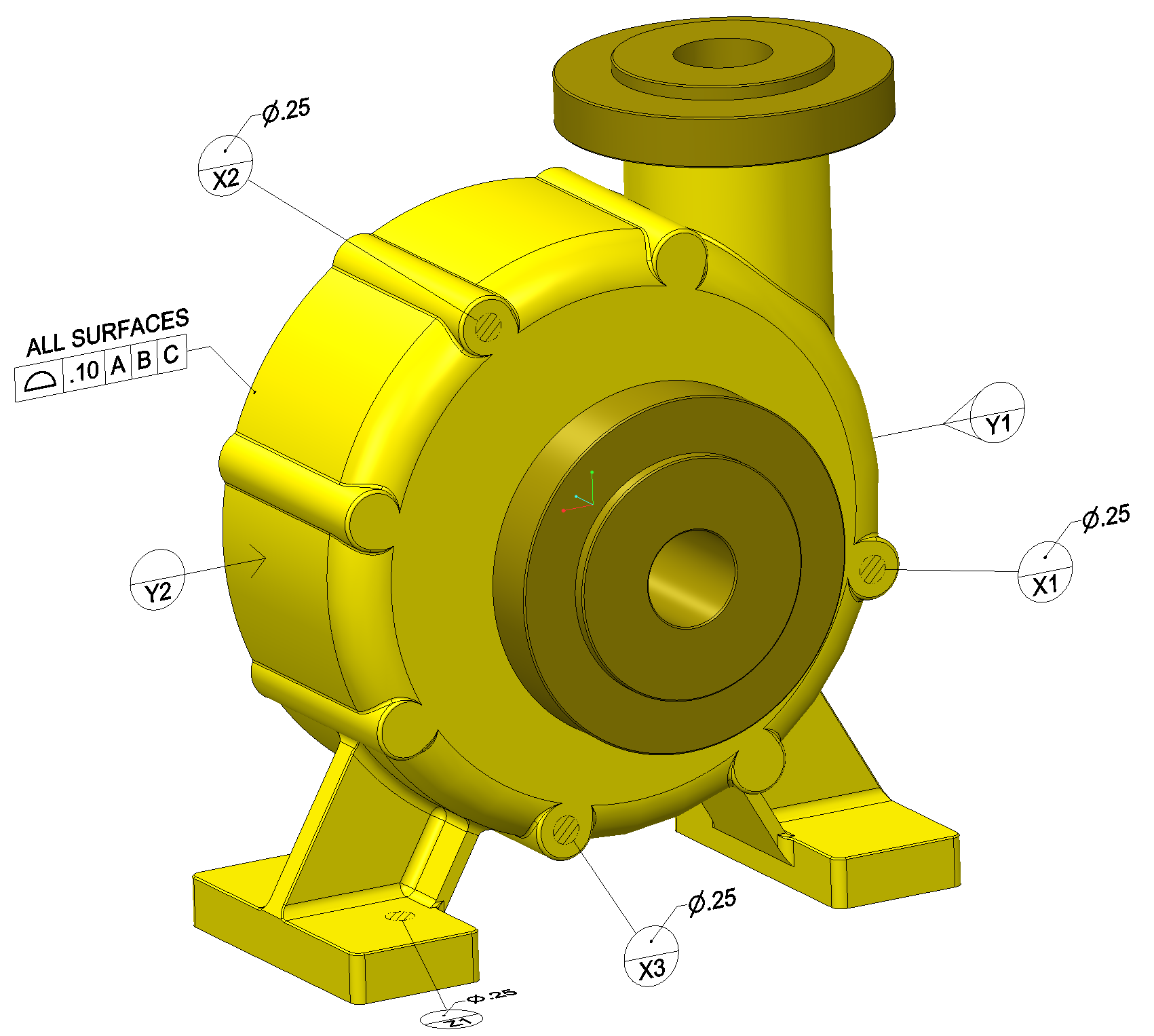 |
| 3D annotations (dimensions and tolerances), metadata, notes and attributes needed to define the product beyond the 3D geometry. |
| A system that manages as-inspected data and is the authoritative source for quality records. |
| A set of data that specifies the standards, practices, specifications, resources, and activities required to validate engineering requirements, including compliance objectives, process steps, and responsible parties; typically includes testing, inspection, examination, and audit programs at appropriate stages. |
| Identifies what data serves as the primary and governing source. Additional data may be derived from this source and additional data may be added to support the manufacture or inspection of the product. |
| A model value that is rounded off to the number of decimal places required for the design. |  |
| Standard for The Exchange of Product model data, the common name for ISO 10303. |
| The process of adding structured, machine-readable data with geometric model elements so that it is digitally consumable |
| A model that contains a sketch, surface and/or solid model used to facilitate top-down modeling, by allowing multiple users to access interface geometry from a single model. When the skeleton model is changed, those changes are proliferated to any associated geometry in other models that use the skeleton reference geometry. A skeleton model will always have ZERO MASS, as it is a reference-only model. |  |
| A two-dimensional profile used to create a CAD feature. May or may not be constrained to a part's coordinate system, planes, or axis. |
| An assembly which has a total of all components (Company, Industry (including fasteners), Supplier), including all the instances (not unique parts) in the assembly are less than 200 parts. |
| An approach to manufacturing that leverages 3D data and factory machinery with sensors to monitor and improve the production process and performance. |
| A mathematically accurate 3D representation of an object. A solid model has thickness, and when calculated, results in numeric values for mass, center of mass, and Moments of Inertia (MOI). A solid model is not a collection of disconnected, unstitched surfaces. | 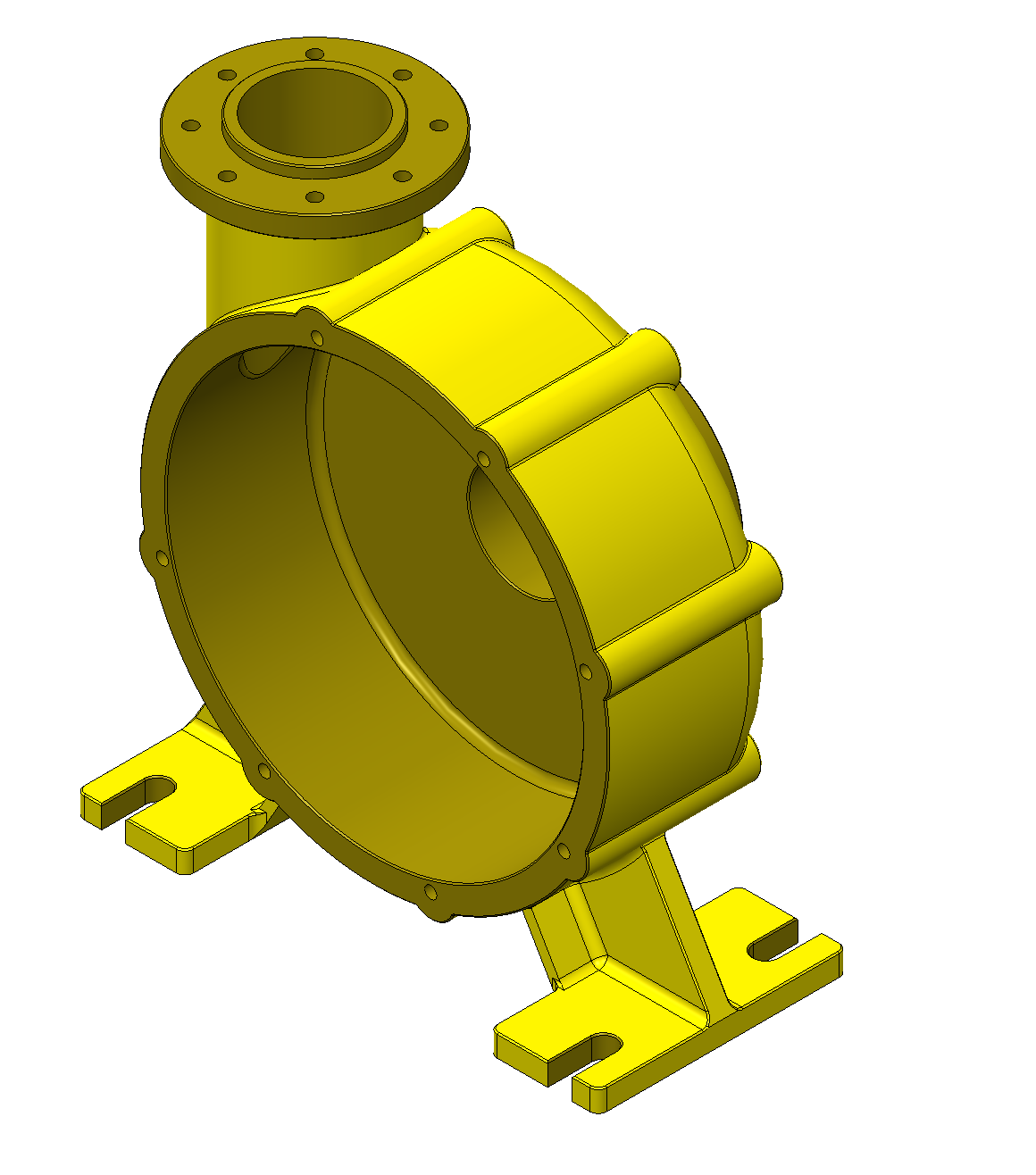 |
| A mathematical or digital representation of an object as a set of planar or curved surfaces, or both, that may or may not represent a closed volume. |
|
Model-Based Definition (MBD) is a model with PMI (Product Manufacturing Information) and consisting of:
1. the 3D geometry (serves as the basic dimensions) 2. the annotations (displayed notes, dimensions and tolerances or GD&T) 3. the attributes (metadata, key characteristics, and queried data) 4. the presentation states (saved views, presentation organization)
|
| A subtractive generative design process that refines an existing 3D geometric model. |
| The conversion of a 3D CAD model from one format to another. |
| An activity that assures that a product satisfies intent. |